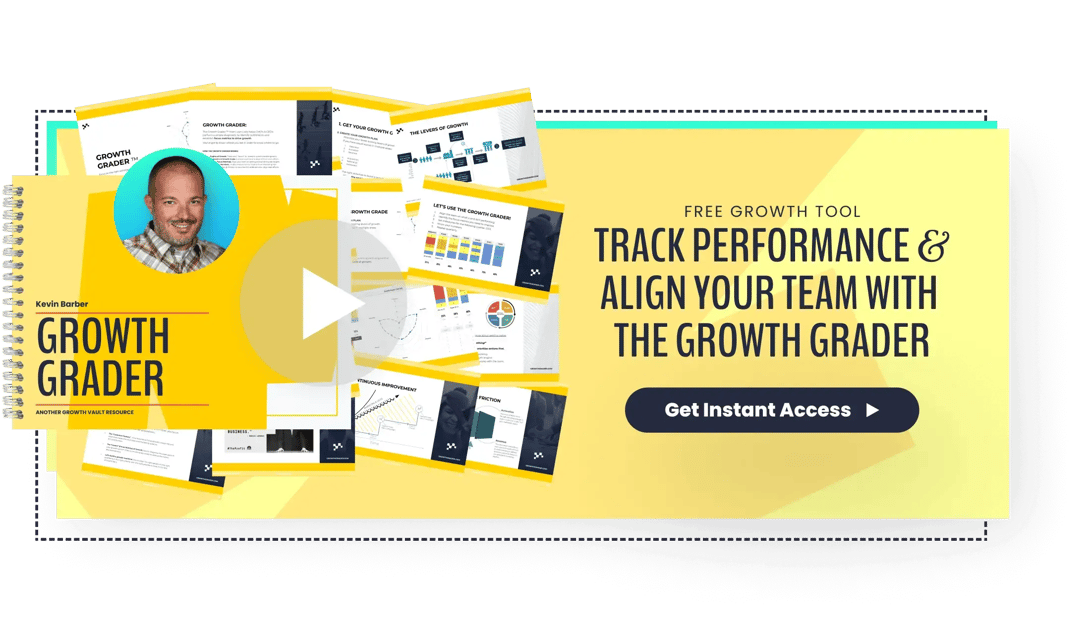Every great story has a hero. Every great hero has a guide. Together, they grow and eventually transform. But wait, what does this have to do with marketing?
It turns out quite a lot.
As a marketer, sales representative, or business owner, your job in the modern world is to guide your customers to success, hopefully using your product or service. You must build trust, empower, and inspire consumers to achieve their goals and aspirations.
It might sound daunting, but thankfully, there are five fundamental elements to inbound marketing that help form connections and solve problems for your audience in the right way.
This blog post explains the five fundamentals of inbound marketing and how you can start to implement them today.
VIDEO TRAINING
Get The Growth Marketing Playbook.
Learn to plan, budget, and accelerate growth with our exclusive video series. You’ll discover:
- The 5 phases of profitable growth
- 12 core assets all high-growth companies have
- Difference between mediocre marketing and meteoric campaigns
Thanks for submitting the form!
We'll review the information you've submitted and respond to you just as soon as possible.
What are the 5 Fundamentals of Inbound Marketing?
The Inbound methodology is a customer-centric marketing approach. It’s a method for growing your business by building human relationships with prospects and customers. As a business, you’re a guide to a hero, and you provide value at every stage of their journey with you.
Related read: What is Inbound Marketing and How Does it Drive Long-Term Growth?
The inbound methodology considers every stage of the buyer journey and is applied in three ways:
- In the attract phase, you want to draw people in with relevant and valuable content that helps them learn about you and your product.
- In the engage phase, you aim to educate your audience further and build trust, so they are more likely to buy from you.
- In the delight phase, you go above and beyond to turn customers into lifelong fans.
Lean Labs is an outsourced growth team dedicated to being a partner in your marketing efforts. We’re all about the customer journey and making it work for you. Download the Lean Growth Playbook to learn how to convert leads into delighted customers.
Fundamental #1: Contacts
The cornerstone of inbound marketing is establishing human relationships. Establishing those relationships depends on your channels, where your potential customers are, and how you decide to reach them.
Regardless, once you establish a relationship, where do you organize and track them? You need CRM (customer relationship management) software to manage customer relationships properly. A CRM is one central palace to collect all the details of your customers and leads.
Contacts aren’t only limited to potential customers. They might also be people who left details but haven’t engaged with your brand; they might be former clients, industry experts, people from other companies, or brand fans.
Now, it’s no use having a database of contacts if you don’t interact with them. A robust CRM that manages your relationships is a must. The best CRM software providers have thought of everything. They have all the tools marketers need to execute excellent marketing campaigns, from lead generation to email marketing and social media management to SEO.
Keeping detailed records on your contacts allows you to segment your audience and track their buyer journey.
Fundamental #2: Buyer Personas
Think of a buyer persona is a fictional representation of the heroes you want to guide. You have to know who your customers are and understand that they might change and grow over time. Knowing your customers allows you to personalize your messaging and position yourself as someone who can solve their problems.
To personalize your messaging for different segments, think of their:
- Demographics: Age, sex, income, family life, and hobbies.
- Buying habits: Their priorities, what looks like success for them, the barriers they need to overcome, how they evaluate options, and attributes they pay attention to when making a decision.
If you’re trying to speak to everyone, you might talk to no one. Your messaging will be too broad and muddled. Instead, filter out folks who aren’t a good fit and talk to your buyer personas like they’re real people (which they are).
How to Determine Your Buyer Persona
You can acquire data through your website, your CRM software, and social media (both organic and paid) and start to build a buyer persona. A goldmine of information comes from surveys, forms, and your sales teams, but one of the best avenues to tread is conducting buyer persona interviews.
Interview your customers, people who considered you but chose a competitor, those who didn’t consider you, and referrals. If they’re up for an interview, make sure you’re prepared with questions that will help you build a buyer persona. Find out about them, why they chose or didn’t choose you. What their role is, how they consume information and what their decision-making process is.
Look for themes and patterns and build your persona.
Fundamental #3: Define the Buyer Journey
Once you have identified a buyer persona, you need to plan out their journey. You want to guide them from relative strangers to paying customers and raving fans. To be customer-centric, you should personalize their journey and experience.
Create content that’s relevant and useful.
To inform your B2B content marketing strategy, ask yourself where your buyer persona is in their journey. Let’s look at the three stages of the buyer journey.
- Awareness: The buyer experiences a problem and wants to understand their symptoms
- Consideration: The buyer has identified their problem and is committed to solving it
- Decision: The buyer identifies the correct solution and decides on the best vendor to work with
What are people searching in Google when they want to find answers to their questions? Here’s an example:
- Awareness: Why am I not losing weight? Oh! Yes, I do eat when I’m emotional.
- Consideration: How can I stop myself from overeating when I’m emotional?
- Decision: Who can help me to stop eating when I’m emotional? How much will it cost? How do I know they are a reputable nutritionist?
Now you have an idea in mind, you can create content to align with your audience and potential customers.
Fundamental #4: Create Content for the Buyer’s Journey
Remember, you want to earn attention, not steal it. An excellent content strategy is one of the keys to growth. With content built around your buyer persona and their journey, you can answer questions that real people are asking.
You might use an SEO tool to understand what people are searching for and develop titles and articles, videos, webinars, and other forms of content.
If we break your content strategy down into the three stages of the buyer journey, you have a roadmap.
- Awareness: Speak to your buyer’s symptoms, problems, and challenges. You can also help them understand and identify their problems. Empathy goes a long way to building trust.
- Consideration: Here, you can educate buyers on their solutions. Good practice here is to segment your audience depending on how they interact with you. You might communicate with them on social media or email marketing to send them to webinars or relevant blog posts that further educate them and highlight solutions to their challenges.
- Decision: Highlight the value of your solution and convince prospects to choose you. It’s that simple. Why would they choose you? Have you helped other people in their shoes? Provide use cases, testimonials, and examples of where you’ve gone above and beyond for your customers.
Once you know how you’re going to reach your customers, you need to think about the type of content you’ll create. Remember, you’ve found out where your audience is and how they like to consume content. Use that information to decide whether you’ll focus on written, visual, or audio content or mix all three!
Start thinking about creating content that drives action, creating compelling CTAs that align with the buyer journey, and distributing your content to the proper channels.
Fundamental #5: Set Goals
Finally, it’s time to decide on measurable goals that help you determine what’s working and what isn’t. You need to know your numbers. We talk a lot about setting SMART goals. Set specific, measurable, attainable, relevant, and time-bound goals. For any marketing effort, you must:
Specific - Nail your next steps
Measurable - Track progress; you have the tools to do it!
Attainable - Achievable, short-term goals
Relevant - Move in the right direction
Time-bound - Set a due date and time frame
What are your objectives? For inbound marketing, you want to build brand awareness, increase engagement through your website, social media, and email campaigns, and convert leads to customers. These all break down into metrics that can be tracked.
Metrics and results show what’s working and what isn’t. With established benchmarks, you set targets. If you hit your targets, double down on those strategies and try to improve upon them. Try a different approach or strategy if you don’t hit your targets.
Start Implementing the 5 Fundamentals of Inbound Marketing Today
Buyers have the power in today’s world. They know what they want to consume, when, and how. Irrelevant messaging is a thing of the past. In fact, 94% of consumers have discontinued communications with a company because of irrelevant messages.
Inbound marketing allows you to help people in a human way. Share knowledge with the world and let your customers find it. They will align with you if you speak to their challenges and problems. The best part is you can leverage all the data you collect as part of your inbound strategy to create a delightful end-to-end experience.
Lean Labs is an inbound marketing agency with a difference. We apply the inbound marketing principles, but we help you achieve your goals by focusing on growth and expert customer acquisition.
Our lean growth playbook is full of resources to guide you towards a growth mindset, and once you’re there, we may just be the right growth marketing team for you.







